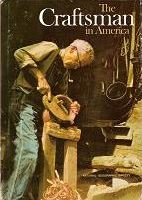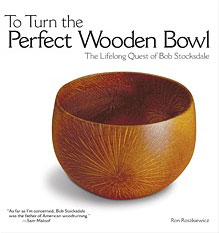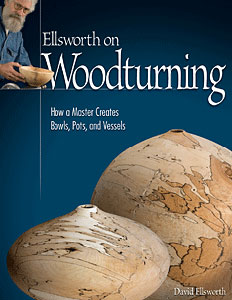
I have always been a book kind of guy and on many subjects I would almost as soon read about it as
do it. There are dozens of books in my home on many topics of interest, but as you can imagine,
woodworking and turning are two of my favorites. I was cleaning out a few books a while back and
came across an old favorite from some years ago. It was published by the National Geographic
Society in 1975 as part of a series on many different topics. This one is called "The Craftsman in
America" (now out of print) and as I thumbed back through it I realized that much of what I love to work on and really
admire springs from this book.
In the introduction, Gilbert M. Grosvenor captures what I think may
be the feelings of every craftsman in the world: "Every morning when I dress for work, I smile
smugly at the quiet, smooth way my chest of drawers opens and closes at a slight touch of a
fingertip. The early sun's rays reflect the warm matched grain and the rich color of the wood. My
pleasure goes beyond mere ownership, for I built that chest myself from teak I imported from Burma
and carefully aged in my basement workshop for two years." I know exactly what he meant. I have a
table I made at the back door, a lamp table in the den, a clock in the hall and another on the
mantle, all of which I made with these two hands and enjoy every day. Bowls I make for sale sit in
my dining room so I can see and touch them every day and sometimes I consider keeping all of them.
Would you sell your children?
In the National Geographic book from 1975, they featured Sam Maloof, who died only recently after a
long career in woodworking. We should all be so good; that was 35 years ago and he was well known
even then. Of course there were many other craftsmen in the book, among them, Bob
Stocksdale, wood turner extraordinaire. In fact, in the picture of Maloof's furniture, the bowls on
the table were by Bob Stocksdale, taken in trade for some Maloof furniture. What a deal on either
side of that exchange!

I bought a book at Highland last week about Bob Stocksdale and it is quite well done. The title is
Turn the Perfect Wooden Bowl, the Lifelong Quest of Bob Stocksdale
by Ron Roszkiewicz. It is a perfectly delightful little book, full of color photos of bowls plus many other
photos of Stocksdale at work. Apparently he was not always a very social fellow; he just wanted to
work in his shop and not be bothered by guests, students or writers. He collected wood from all
around the world and when he passed away a few years ago, his shop was filled with literally tons of
wood. Some of it was good and some of it was not and some of it was good firewood. That didn't
bother him, because as he explained, he had two fireplaces. I like that.

Another book I really enjoy is
Ellsworth on Woodturning
, subtitled "How a Craftsman Creates Bowls, Pots & Vessels" by David Ellsworth.
This is a big glossy book by another master of the craft. Ellsworth is the inventor of the
eponymous Ellsworth Signature Gouge, which is one tool I have not managed to purchase yet, but I
admit I am intrigued by it after reading this book. This is more a reference book than some you
see, and I intend to make this a step-by-step instruction book on hollow forms – the next step in my
turning education.
Besides that, how can you pass up a book with a whole chapter on proper
exercises before beginning work? Ellsworth starts his turning classes with everyone stretched out
flat on their backs on the floor. He also has a small trapeze in the ceiling of his shop which
he uses to hang by his hands several times a day to keep loose and flexible when he is working at
the lathe. And I don't think I have ever seen instruction on how to plant your feet versus your
elbows and hands while holding the tool at the lathe. Who would've thought?
I think the main thing I get out of books like these is "possibility." Somehow I can fool myself into
thinking that if those guys can do it, then I can do it. Seeing it broken down into steps and
watching someone do it just opens up all those possibilities to me, and I am empowered to start.
Once started, I find that I can usually get better and then off I go.
I promise not to buy a book on brain surgery.
Terry Chapman, a retired engineer, lives in Fairburn, Georgia.
He writes an entertaining blog at
www.asthewoodturns.blogspot.com
.
His turned bowls are available at
www.thewoodshop.etsy.com
.
Return to
Wood News
front page
